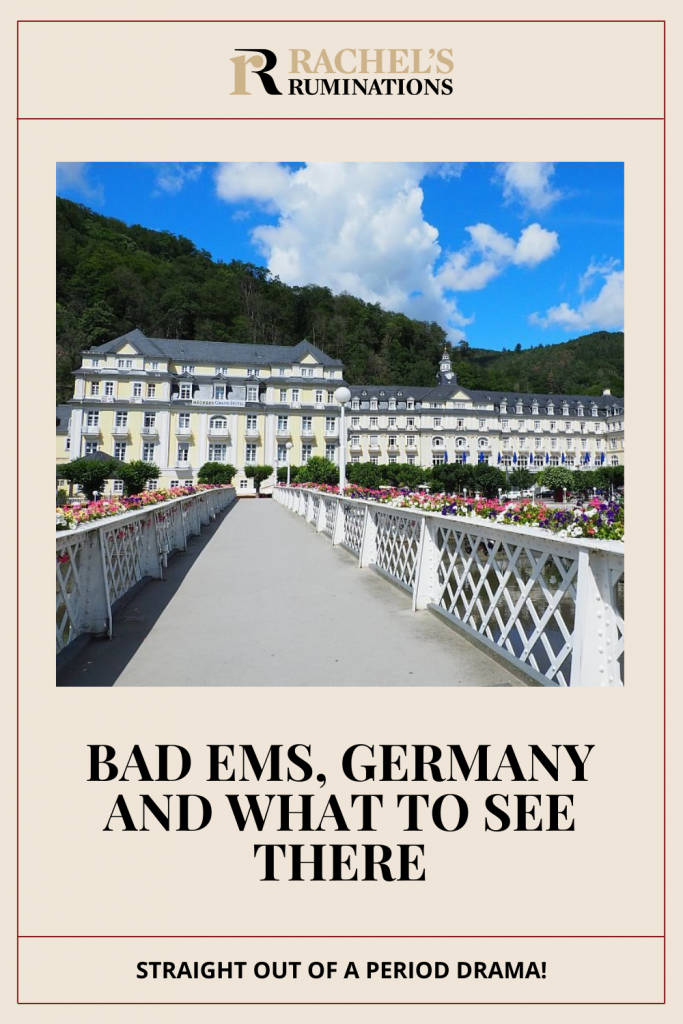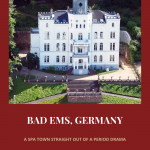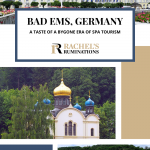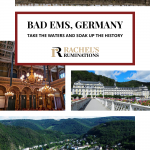Thermal spa town Bad Ems, Germany
I’ve written before about the evocative atmosphere of the days of “taking the waters” in thermal towns like Bad Ems, Germany. It’s the social scene depicted in period dramas, with wealthy men and women strolling through parks, socializing and flirting. The women have long skirts, of course, and carry parasols so they won’t brown in the sun. The men wear long jackets and top hats.
Bad Ems, Germany, still reflects that history. Its core is essentially unchanged, so it’s an easy place to imagine that historical period.
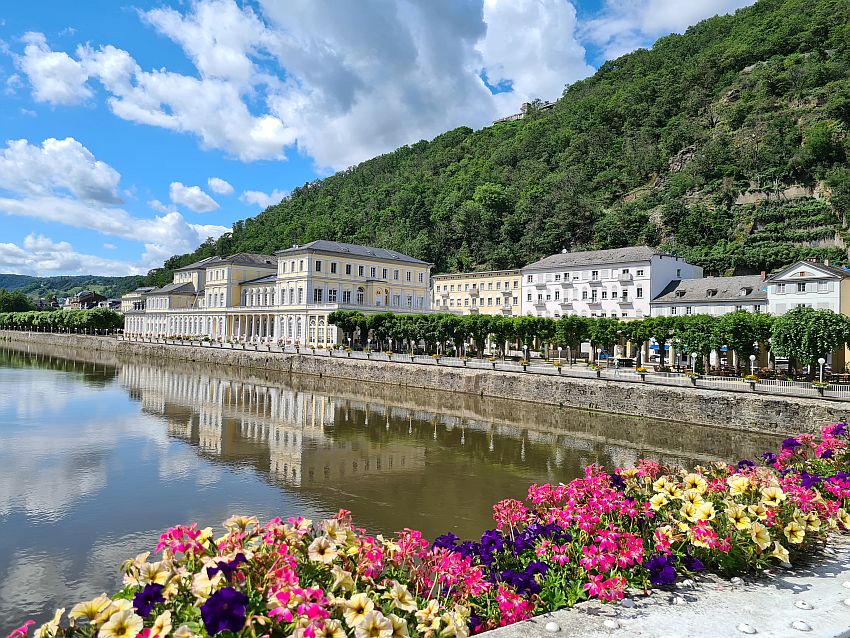
Disclosure: This article was sponsored by Touristik Bad Ems-Nassau and by Emser Thermen. Neither organization has any influence over what I write.
Another disclosure: This article contains affiliate links. If you make a purchase through one of the links, I will receive a commission. This does not affect your price.
History of Bad Ems, Germany
Bad Ems was a thermal town at least as far back as the Middle Ages, though the Romans may have bathed here as well when it was right on the border of the Roman Empire. In the Middle Ages and over the next few centuries it was a popular spa for all levels of society, not just the elite.
Bad Ems in its heyday
Starting in the 19th century, Bad Ems and other thermal towns across Europe became playgrounds of the European royals, the Russian tsars, and the nobility from all over Europe. With the industrial revolution, a wealthy industrial class appeared. At the same time, the construction of a rail network made it easier for the wealthy and the middle-class to travel. If they were lucky, they could even hob-nob with royalty and the noble classes. Artists, musicians and writers like Goethe and Dostoyevsky joined them.
It was, in a way, an early form of mass tourism. The towns that attracted them built hotels and facilities to cater to these visitors, who came to “take the waters,” whether that meant drinking the mineral-rich spring water or bathing in it. Mostly, though, they came to see and be seen, to make marriage matches and to strike business deals.
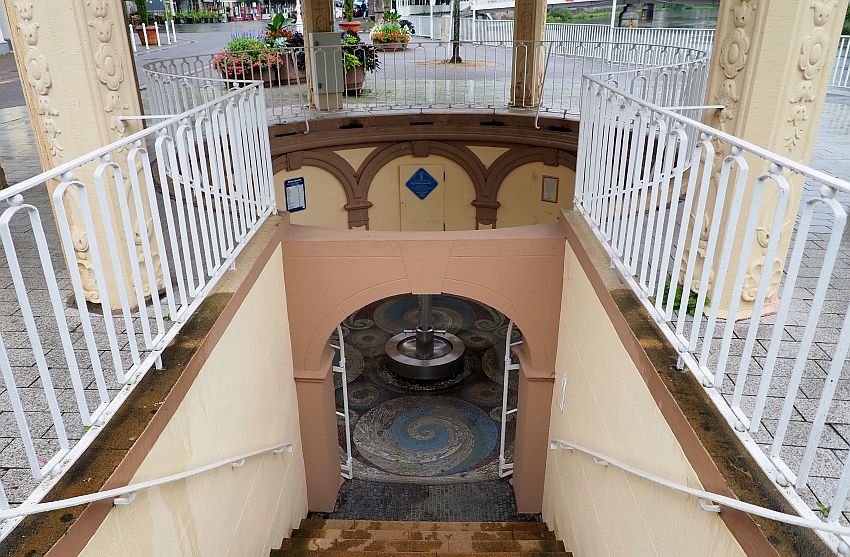
In Bad Ems in particular, this mingling only went so far. For the most part, the royals and nobles stayed on one side of the river that divides the town. Some, particularly the Russian royal family, sometimes booked up an entire hotel for their entourage. On the other bank, the wealthy commoners lodged in hotels or built themselves large villas.
This phenomenon ended with the wars, particularly World War II.
Post-war Bad Ems
After that war, starting in the 1960s, German insurance covered taking a kur at Bad Ems or other spa towns. Generally those whose treatment was paid for by insurance stayed in clinic hotels, which weren’t as fancy as the places that catered to the wealthy. Mostly these clinic hotels were hidden on the other side of the large hill that backs the small town.
Even today, people go to Bad Ems for “rehabilitation.” There are lots of clinics and doctor’s offices of various sorts in town, and people with mobility issues – using crutches, for example – are a common sight.
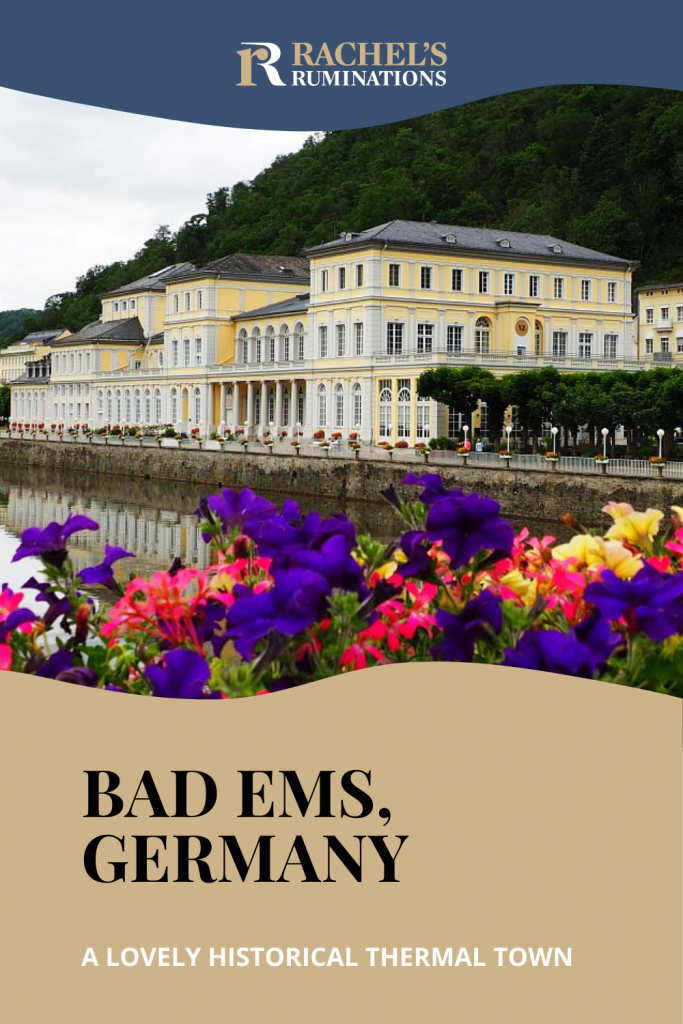
Things to do and see in Bad Ems, Germany
1. Take the waters at Bad Ems Therme
The main pastime in Bad Ems, of course, is going to a spa. Bad Ems Therme (called Emser Therme) is a modern spa with a range of ways to take the waters. It has pools of various temperatures, many with bubbles or jets, both indoors and outside. A sauna section (naked) has a range of dry and wet heat areas. Visitors can relax on lounge chairs, breath salty air in a special room, and so on. The spa also has a fitness room and various treatments such as massages at an extra charge.
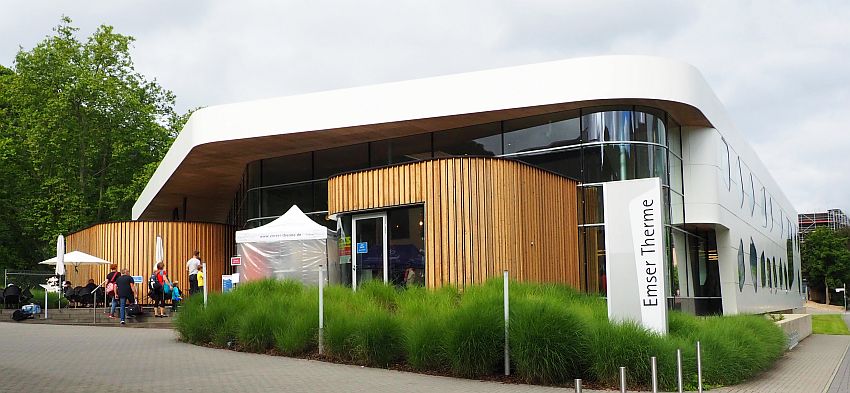
We spent a couple of very pleasant hours trying out the pools, moving from warm to hot to cold and so on. There are places where water gushes downward from above; we could sit or stand and allow it to pummel our backs like a massage.
Bad Ems Therme: Viktoriaallee 25. Admission for spa/spa+sauna: €13/€18 for 2 hours, €17/€22 for 3 hours, €21/€26 for 4 hours. Website.
2. Check out Häcker’s Grand Hotel
You can’t miss Häcker’s Grand Hotel, an enormous, almost palatial building on the river. Its lobby is definitely worth a visit. While what you’ll see there mostly dates to a 1912 renovation, it still evokes the days of “taking the waters.” There are even fountains in the lobby with water piped straight from the hot spring under the site. Part of the hotel rests on the foundations of the original 14th and 15th century bathhouses that stood here.
Make sure to check out the bar in the lobby too, at the far end from the reception desk. Entirely covered in geodes, it makes a truly unique sight.
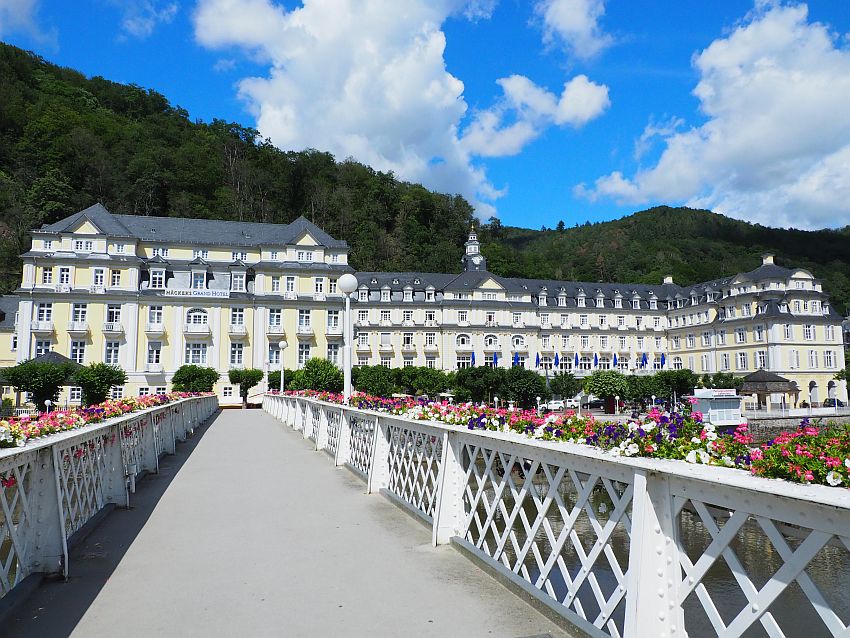
The hotel is also home to a small spa and wellness center. Despite its relatively small size, it is remarkably grand, with its marble columns and painted ceiling over the indoor pool. The water is naturally at 32°C (90°F).
The spa includes a sauna area (naked) with saunas and steam bath. There are whirlpools inside and outside in a small garden, which also holds another sauna.
Häcker’s Grand Hotel Thermal Bath and Saunas: Admission €20; free for hotel guests. Wellness treatments cost extra and if the spa is too busy it might be closed to people who aren’t staying in the hotel. Website.
3. Promenade
The original spa town of Bad Ems extends along the Lahn River, a Rhine tributary, with steep hills on both sides, so the whole town is only a few blocks wide on either side of the river. You’ll get a good feel for what the place was like in its heyday by taking a walk along the river, crossing, then taking a walk back. It’s still pretty much exactly as it looked then. The path along the river was their “promenade,” at least as long as the weather was good. Along the way you’ll come upon several fountains whose water – yes, it’s safe to drink it – is warm and tastes mineral rich.
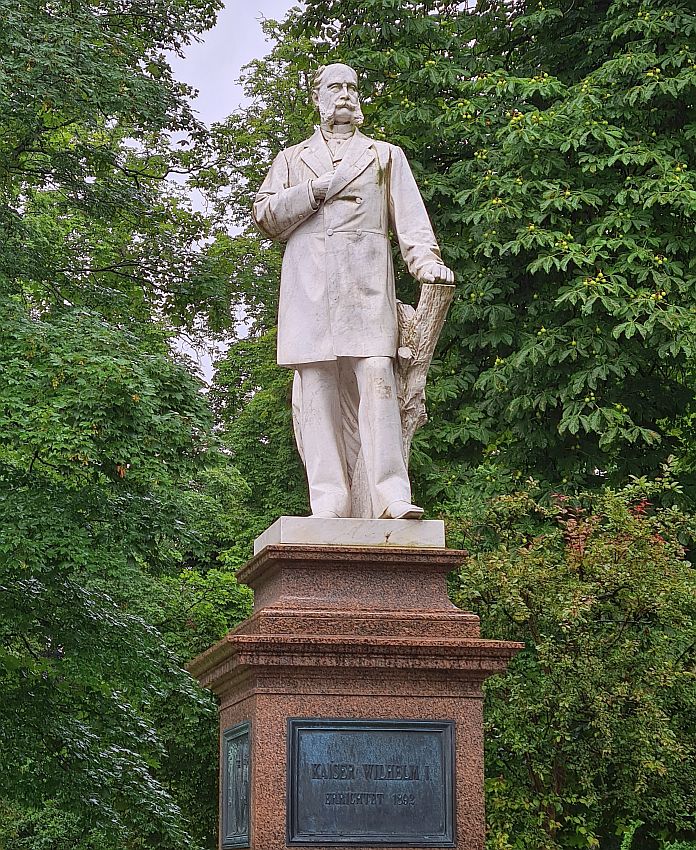
You’ll pass the Kursaal (more on that below); a gazebo; a park with a very imposing statue of Kaiser Wilhelm, a frequent visitor; and lots of period buildings along the way, many of which used to be hotels.
Notice the four towers building at Römerstraße 41. It dates to 1696, when it was built as a residence. It later became a very upscale hotel that royals frequented.
The neo-gothic St. Martin’s Church is worth going inside. For one thing it’s a very pretty church in general, but also make sure to take a close look at the altar. This Gerhard Rumpf design from 1985 holds images of a range of totally imaginary fish. Look for the Kaiser Wilhelm fish: the one with the Kaiser Wilhelm beard (like the statue in the park).
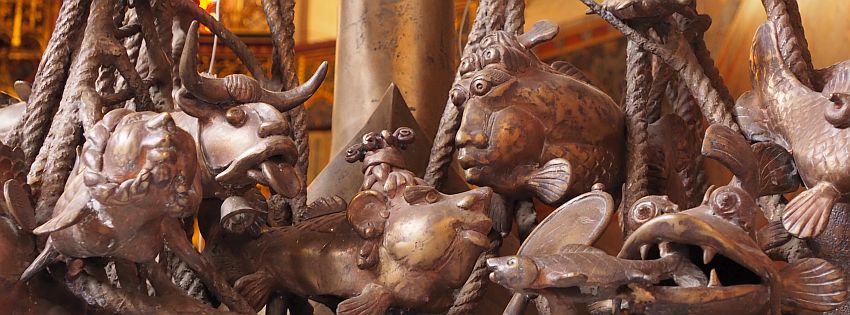
The Kursaal
This beautiful building contains a grand hall (Marmorsaal or Marble Hall) with marble columns and an ornate, colorful ceiling that dates to 1836-1839. Next door is an elegant little theater, added in 1913-14. In the thermal town’s heyday, the Kursaal was both a gambling hall and a concert space, but, more importantly, it was the place to mingle when the weather was too bad to promenade by the river.
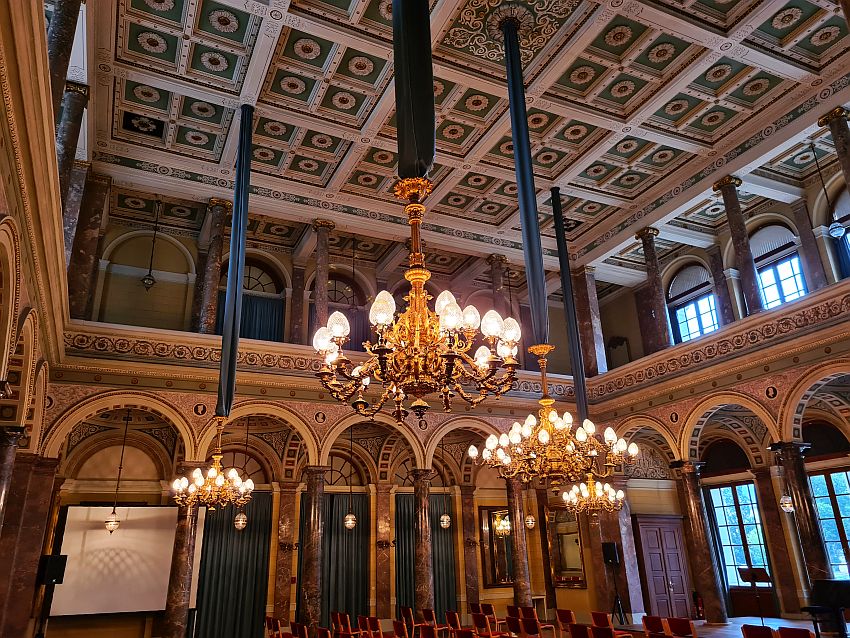
Today the Kursaal still holds a casino, added to the building in the early 20th century as a concert hall. The Marble Hall and theater are still used for concerts and other events.
The Russian Orthodox Church
As you walk the promenade you’ll easily spot the Russian Orthodox Church on the opposite bank, with its gold onion dome. Bad Ems residents started its construction in 1857, but didn’t complete it until 1876 when Tsar Alexander II contributed money. It catered to the Russian royals and nobility who came here.
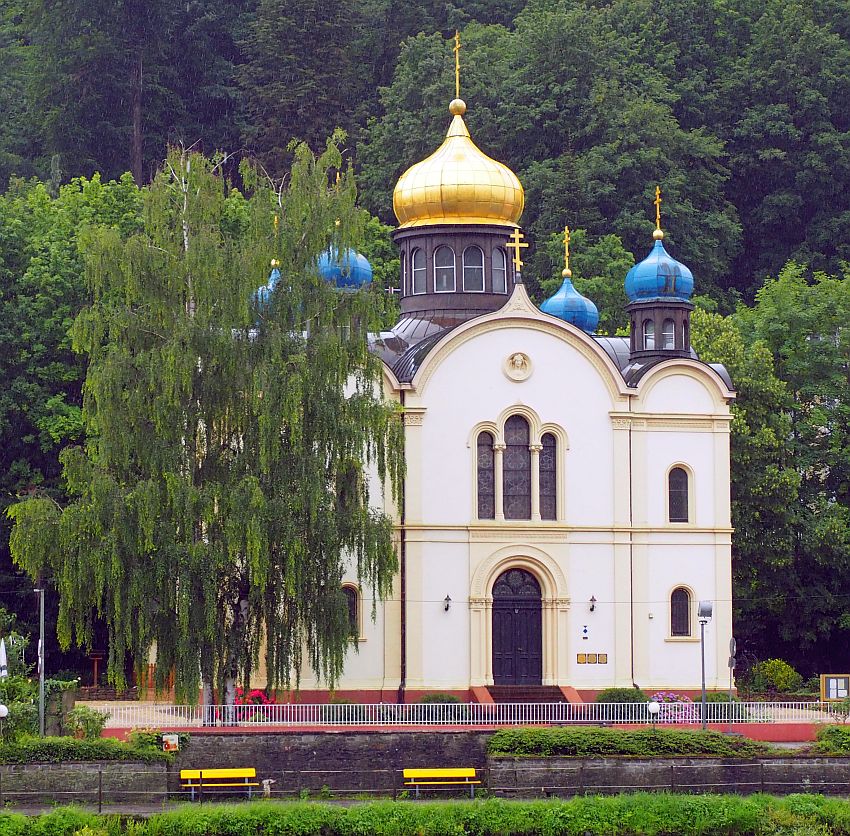
St Alexandra Church: Wilhelmsallee 12. Open Tuesday-Friday and Sunday 14:00-17:00, Saturday 13:00-16:00. Closed on Mondays. Website.
Balmoral
Another thing you’ll notice on the same side of the river as the Russian church, is a number of large villas. One of them stands out because of the fake crenellations along its roof and its central turret, evoking a castle. Built in 1867-68 for a wealthy Russian named Vassili Miakoff, it’s a typical example of the 19th-century popularity of the medieval – see my article on the real Balmoral or this one on Castle de Haar – and, funnily enough, locals call this villa “Balmoral” as well.
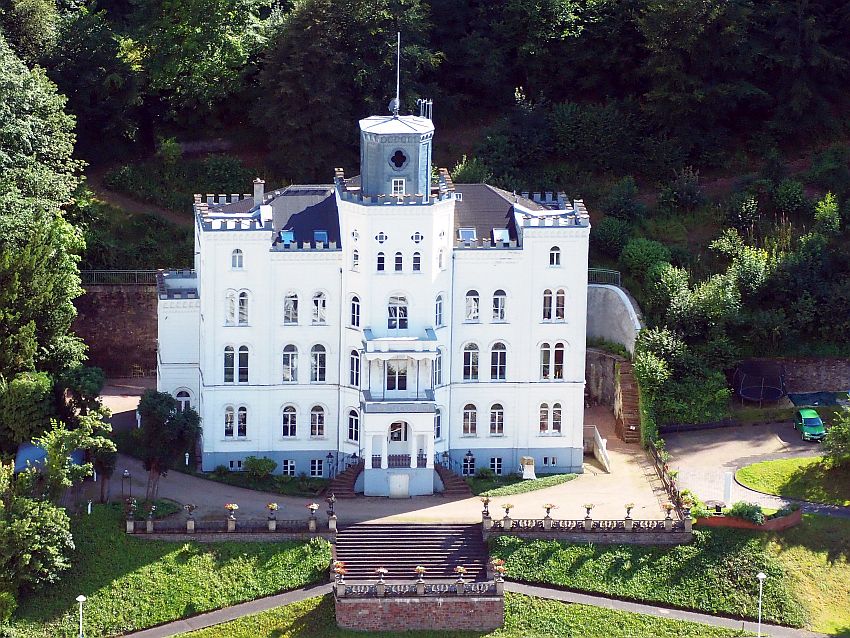
Schloss Balmoral: Villenpromenade 11.
Museum Bad Ems
This typical local museum is on the main road parallel to the promenade. It has a few interesting exhibits, particularly about the fact that this village was on the dividing line between the Germans and the Roman empire. It’s worth a quick 15-minute visit: more if you can read German, since all of the signage is in German.
Museum Bad Ems: Römerstraße 97. Admission free. Website (only in German. Use Google translate).
The Beatles Museum and Café Yellow Submarine
Yes, there is a Beatles museum in Bad Ems. Really, though, it’s just one person’s collection, and not a very big one at that, of Beatles memorabilia. It’s on display in a few cases in the back of a café on the same street as the Bad Ems Museum, parallel to the river. Like the museum, it’s only worth 15 minutes at most: we only spent about five minutes because the place smelled of cigarette smoke, which makes me feel ill. There are tables indoors and outdoors where you can get a drink while enjoying non-stop Beatles tunes.

Beatles Museum and Café: Römerstraße 19. Website.
4. Take the funicular
The Kurwaldbahn claims to be one of the steepest funiculars in the world, and I can believe it! It covers 132 meters in elevation in about two minutes. The views from the top are amazing; sit and have a drink on the café’s outdoor terrace with a view.
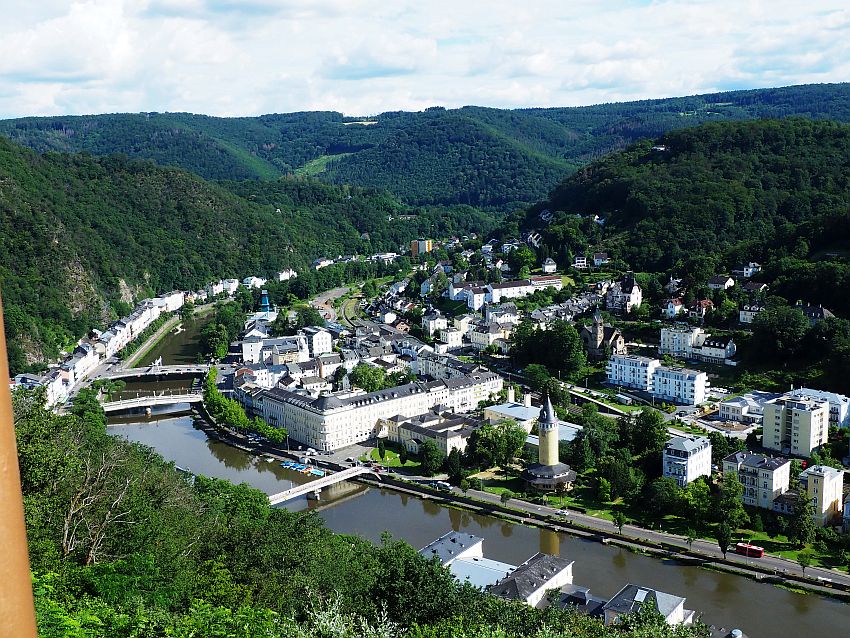
By the way, there is another funicular opposite this one on the other side of the river, but it doesn’t function. It dates to 1887 and is kept as a “technology monument.”
Kurwaldbahn: Römerstraße 18. €2.50 one-way, €4 round-trip. Free for children up to 6 years old. Buy your ticket in the machine inside the entrance. Website.
5. Take a hike
Though we didn’t have time to try any of them, there are many miles of hiking paths in the hills around Bad Ems. One way you can start is by taking the funicular up and choosing one of the many paths of varying lengths from there.
Here are some other articles about places not too far from Bad Ems:
- What to see in Frankfurt in 1-2 days
- Things to do in Freiburg in one day
- Basel, Switzerland: A surprising and delightful trip to see the Basel sights
Or you might like to take a look at some of Rachel’s Ruminations’ most popular articles:
Hotels in Bad Ems, Germany
I should point out that Bad Ems is only about an hour and a half from Frankfurt by car, about three and a half by train. That makes it a great weekend trip from Frankfurt. It’s just outside the city of Koblenz (20 minutes’ drive, 40 minutes by train). It’s also very near the UNESCO-listed Middle Rhine Valley with its fairy-tale castles.
While the town has a number of hotels, Häcker’s Grand Hotel is the grand dame of spa hotels, with massive, old-time décor and lots of marble, but spotlessly maintained. You could easily film a period drama here. Our room was quite elegant – in an old-fashioned way – with a marble-tiled bathroom. It’s the best place to stay to get into the spirit of the place. Book it here.
As I pointed out above, use of the spa is included with the rooms, and you can “take the waters” as well, i.e. drink it from one of the old fountains on the ground floor.
There are plenty of other hotels, of course. Use the map below to find your accommodations:
Restaurants in Bad Ems
Benedetti restaurant in Häcker’s Grand Hotel is quite expensive but also very good. The hotel has a separate Ayurvedic spa and an Ayurvedic restaurant too, if that’s what you’re into. We didn’t try it so I can’t make a recommendation.
Estragon Restaurant, in the block next to the hotel, is a very good Italian restaurant with pizza but also some interesting pasta dishes.
Of course, there are plenty of other restaurants within just a couple of blocks of Häcker’s.
Great Spas Towns of Europe
Bad Ems, Germany is one of 11 spa towns that make up the UNESCO World Heritage property called Great Spa Towns of Europe. The other German ones are Baden-Baden to the south and Bad Kissingen to the east. According to UNESCO, they exhibit “an important interchange of innovative ideas that influenced the development of medicine, balneology and leisure activities from around 1700 to the 1930s. This interchange is tangibly expressed through an urban typology centred on natural mineral springs and devoted to health and leisure. Those ideas influenced the popularity and development of spa towns and balneology throughout Europe and in other parts of the world.”
Read more about the four German thermal towns I visited this summer. Or, if you prefer, read my separate articles about Baden-Baden and Wiesbaden.
Have you ever taken a weekend at a thermal spa town?
